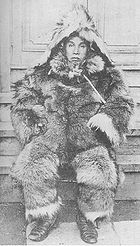
Japanese Antarctic Expedition
Encyclopedia

Heroic Age of Antarctic Exploration
The Heroic Age of Antarctic Exploration defines an era which extended from the end of the 19th century to the early 1920s. During this 25-year period the Antarctic continent became the focus of an international effort which resulted in intensive scientific and geographical exploration, sixteen...
was the first exploration of Antarctic territory by an expedition from Japan. Led by army lieutenant Nobu Shirase, its ship Kainan Maru left Tokyo on December 1910, reaching the ice on 26 February 1911 and sailing on into the Ross Sea
Ross Sea
The Ross Sea is a deep bay of the Southern Ocean in Antarctica between Victoria Land and Marie Byrd Land.-Description:The Ross Sea was discovered by James Ross in 1841. In the west of the Ross Sea is Ross Island with the Mt. Erebus volcano, in the east Roosevelt Island. The southern part is covered...
. It being very late in the Antarctic season, the ship was not able to get beyond Coulman Island
Coulman Island
Coulman Island is an ice-covered island, composed of several connected shield volcanos in the Ross Sea off Antarctica. The Coulman caldera, wide and deep, can be found on the south end of the island. Emperor penguins inhabit this island. Coulman Island lies within the boundaries of Ross...
, and returned to Sydney
Sydney
Sydney is the most populous city in Australia and the state capital of New South Wales. Sydney is located on Australia's south-east coast of the Tasman Sea. As of June 2010, the greater metropolitan area had an approximate population of 4.6 million people...
, Australia, to winter there.
During the following season a second attempt was made to reach an Antarctic landfall, with the specific objective of exploring King Edward VII Land. At the Great Ice Barrier
Ross Ice Shelf
The Ross Ice Shelf is the largest ice shelf of Antarctica . It is several hundred metres thick. The nearly vertical ice front to the open sea is more than 600 km long, and between 15 and 50 metres high above the water surface...
Kainan Maru encountered Roald Amundsen
Roald Amundsen
Roald Engelbregt Gravning Amundsen was a Norwegian explorer of polar regions. He led the first Antarctic expedition to reach the South Pole between 1910 and 1912 and he was the first person to reach both the North and South Poles. He is also known as the first to traverse the Northwest Passage....
's ship Fram
Fram
Fram is a ship that was used in expeditions of the Arctic and Antarctic regions by the Norwegian explorers Fridtjof Nansen, Otto Sverdrup, Oscar Wisting, and Roald Amundsen between 1893 and 1912...
, which was waiting in the Bay of Whales
Bay of Whales
The Bay of Whales is a natural ice harbor, or iceport, indenting the front of Ross Ice Shelf just north of Roosevelt Island. It is the southernmost point of open ocean not only of the Ross Sea, but worldwide...
for the return of Amundsen's South Pole
South Pole
The South Pole, also known as the Geographic South Pole or Terrestrial South Pole, is one of the two points where the Earth's axis of rotation intersects its surface. It is the southernmost point on the surface of the Earth and lies on the opposite side of the Earth from the North Pole...
party. A "Dash Patrol" of seven men from the Kainan Maru then landed on the Barrier and journeyed southward to 80°05'S, at which point adverse weather forced their return. Meanwhile the ship landed another party on the coast of King Edward VII Land, where an exploration of the lower slopes of the Alexandra Range was carried out. Kainan Maru returned to Japan, reaching Yokohama
Yokohama
is the capital city of Kanagawa Prefecture and the second largest city in Japan by population after Tokyo and most populous municipality of Japan. It lies on Tokyo Bay, south of Tokyo, in the Kantō region of the main island of Honshu...
on 20 June 1912.
External links
- Shirase, Nobu (25 March 1912). "Japanese Story of Polar Trip" (PDF). The New York Times. Retrieved on 12 October 2008.
- Members of the Japanese expedition to Antarctica image at the National Library of New Zealand

